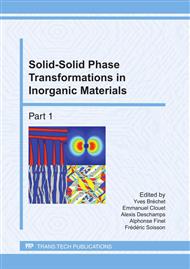p.31
p.37
p.43
p.49
p.55
p.61
p.67
p.73
p.79
Variant Selection in Austenitic Stainless Steel Samples after Cold Rolling and Tension Deformation
Abstract:
The deformation process can induce the precipitation of martensite in austenitic stainless steels. When shear stress is applied at temperatures near Ms, displacive transformation (martensitic transformation) mode is activated. When external stresses are applied, the work done contributes to a change in free energy either raising or lowering the Ms-temperature. Orientation relationships during austenite to martensite phase transformation were investigated in an austenitic stainless steel samples deformed by cold rolling and deformed in a tension test. EBSD (electron backscatter diffraction) and X-ray diffraction techniques were used to evaluate parent austenite texture and martensite texture after transformation. The observed orientation relationship between austenite and martensite was compared with the predicted orientation relationship by the phenomenological theory of martensite crystallography (PMTC). Aspects related to variant selection were discussed based on the criterion for the action of applied stress in the martensitic transformation postulated by Patel and Cohen. Results showed a very good agreement between measured and calculated results.
Info:
Periodical:
Pages:
55-60
Citation:
Online since:
June 2011
Price:
Сopyright:
© 2011 Trans Tech Publications Ltd. All Rights Reserved
Share:
Citation:


